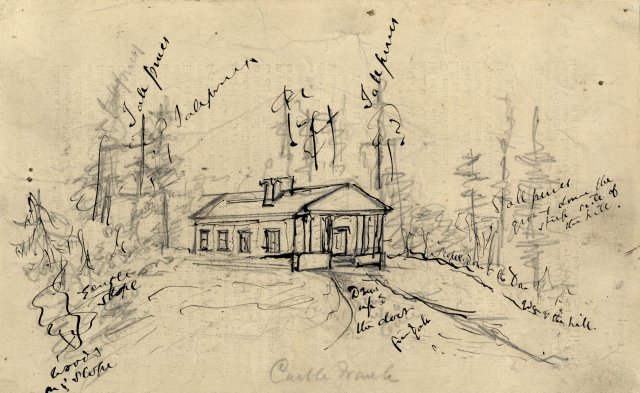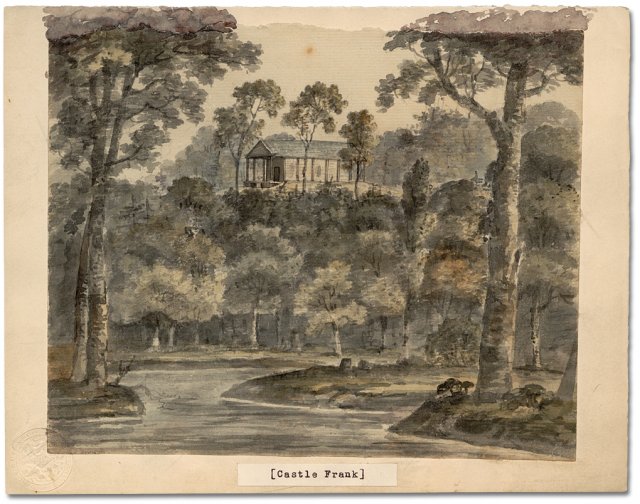Few building types are as intrinsically knit into Ontario's cultural identity as the cottage, the wilderness retreat of thousands of Ontarians who have made these buildings part of their yearly summer traditions and ingrained them into our collective identity. Appropriately, one of Ontario’s first recorded cottages dates back to the very beginnings of Ontario, to the foundation of the Province of Upper Canada and its first Lieutenant Governor John Graves Simcoe. In this inaugural post of our
blOAAg summer series on Cottages, Cabins and Camps we explore the story behind Castle Frank, long considered the predecessor of the modern Ontario cottage and a precursor of many of the sensibilities of early Canadian architecture.
Surrounded by Toronto’s primeval forests of pine, elm and beech trees and built high on a hill overlooking the Don River near present day Bloor Street, Castle Frank was the summer residence of Lieutenant Governor Simcoe, his wife Elizabeth Simcoe, and their children. The cottage was part of a 200 acre property in the wilderness north of the town bought by the Simcoes on behalf of their youngest son Francis - for whom the property was named - when the capital was moved from Newark (modern day Niagara by the Lake) to the newly founded York (now Toronto).

Henry Scadding, 1820, Image Courtesy of the Toronto Public Library
While grand in name, Castle Frank was a modest building reflective of York’s early days – a balance between the rugged nature of the remote British outpost, and the dignity and order associated with the newly established office of the Lieutenant Governor. In its layout and elevation the cottage was reflective of European Neoclassical design principles – an architectural style that had become common in many British civic and institutional buildings. Rectangular in plan (30 feet by 50 feet), the cottage recalled a Greek temple, complete with a columned front portico and a pedimented gable roof. This European design was in contrast with its Canadian materiality. Instead of the finely crafted stone found in Europe, the building was constructed entirely of rough sawn white pine, with the columned portico consisting of four well matched 16 foot tall unbarked pine trees. The resulting cottage recalled Laugier’s depiction of the
Primitive Hut in
Essai sur l'architecture (1755), an idealized architecture emerging from nature that is rustic, dignified, and pure.

Frontispiece from Essai sur l’architecture, 2nd ed., in which Marc-Antoine Laugier outlines his Primitive Hut theory in which all architecture derives from three essential, primitive elements: the column, the pediment, and the entablature.
Humble in scale and rough in detail, Castle Frank remains significant in Canada’s architectural history as one of the earliest examples of the Picturesque Movement. The Picturesque was an artistic concept originating in Britain and characterized by a preoccupation with the pictorial values of architecture and landscape in combination with each other. It was defined as “an aesthetic quality existing between the sublime (i.e., awe-inspiring) and the beautiful (i.e., serene), and one marked by pleasing variety, irregularity, asymmetry, and interesting textures.”1 While the strict and orderly Neoclassical style of Castle Frank does not conform to the architectural qualities associated with the Picturesque, its siting, scale and texture effectively illustrate sentiments fundamental to the movement – namely a romantic setting, a deep relationship between building and landscape, and the idea of the rural retreat. “While the property was not landscaped, the Simcoes took advantage of the native beauty of the wooded setting to visually frame the cottage, thereby creating a picturesque composition of landscape and architecture.”2 This Picturesque quality was captured in Elizabeth Simcoe’s delicate watercolours, where Castle Frank and its surrounding landscape produce a composition that is both sublime and serene. This preoccupation with the Picturesque – and more generally the relationship between building and landscape – would become a leading preoccupation in Canadian architecture in the coming decades, and is still visible to this day.

Castle Frank, 1796, Elizabeth Simcoe - sketches, Simcoe family fonds, F 47-11-1-0-228, Archives of Ontario
Like modern day cottages, Castle Frank provided a weekend escape for the Simcoe family and their friends, hosting numerous parties and social gatherings far from the noise and crowds of York. Unfortunately, work on the cottage stopped in 1876 after Simcoe and his family left Canada due to poor health. The cabin passed through several hands and was eventually abandoned, used by hunters and fishermen who frequented the area. In 1829 the cottage was lost to a fire, erasing any evidence of one of the earliest examples of this quintessential Ontario building type. Today, Castle Frank is remembered by name in streets and a subway station located in the vicinity of the original cottage, as well as in the watercolours and diary entries of Elizabeth Simcoe, and the written works of local historians like Henry Scadding.
Sources:1. "Picturesque". Encyclopædia Britannica. Encyclopædia Britannica Online. Encyclopædia Britannica Inc., 2016. Web. 29 Jun. 2016 <https://www.britannica.com/art/picturesque>.
2. Janet Wright,
Architecture of the Picturesque in Canada, Parks Canada, 1984